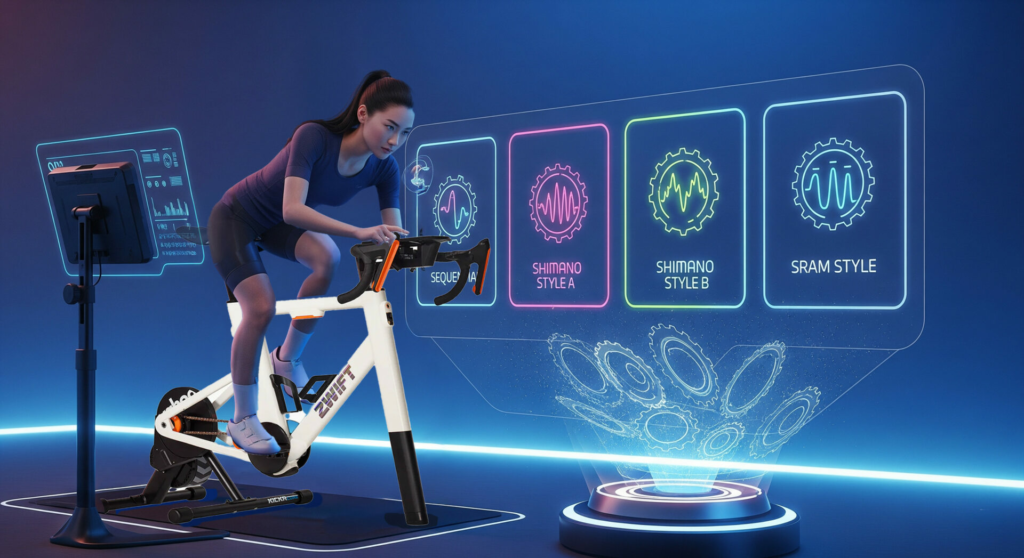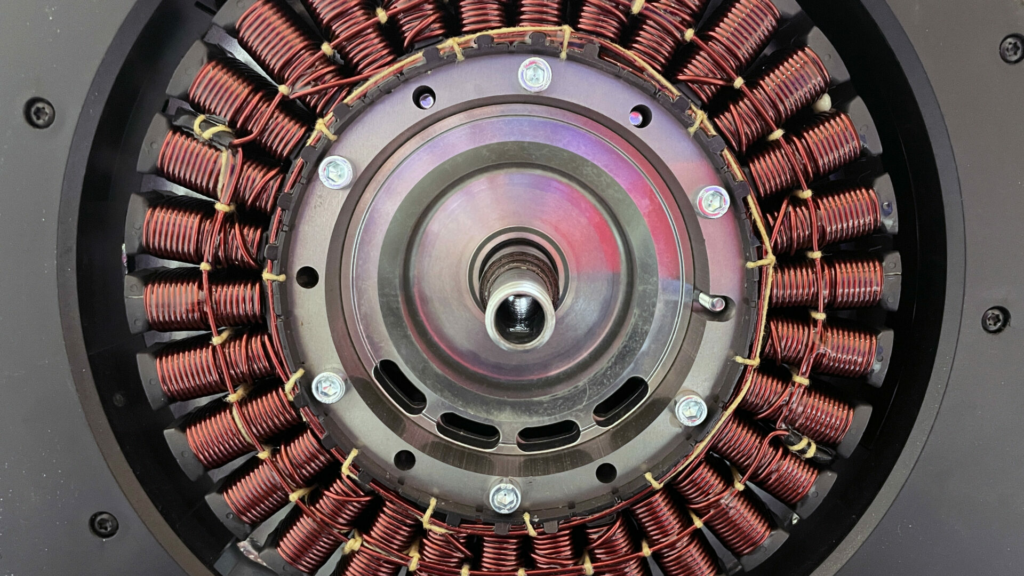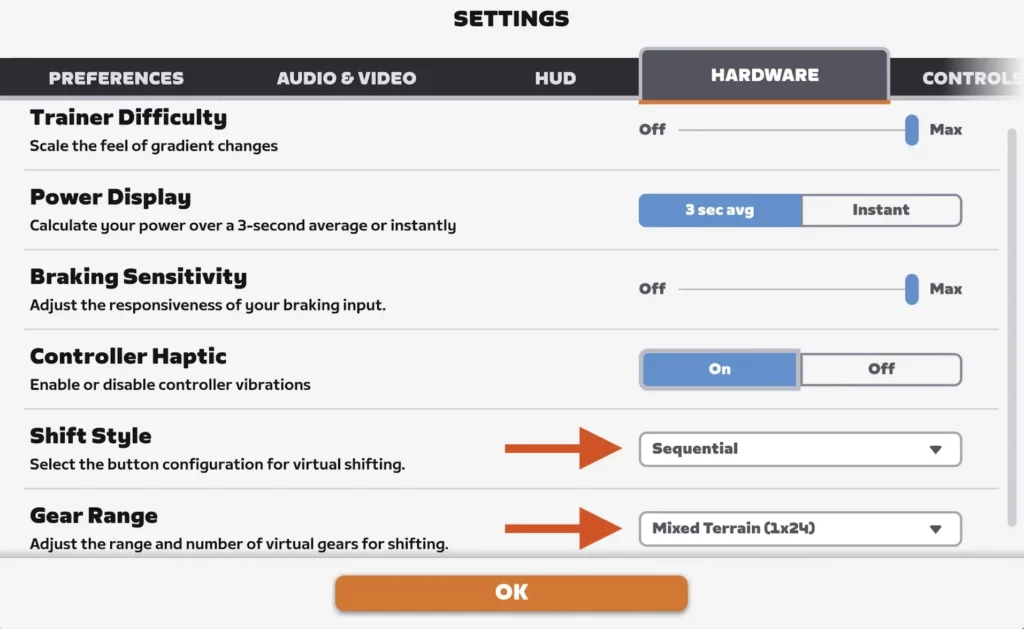TL;DR
Heads up—this post gets a little nerdy! If technical talk isn’t your thing, feel free to skip to What’s Special About Zwift Ride Gearing for OWLs and the Shifting Style and Gear options I chose for my Zwift Ride. No hard feelings—I promise!
Next on the docket of my Zwift Ride series—where virtual cycling dreams come true and everyone wins on the sprints—it’s time to shift gears, literally! We’re diving into the nitty-gritty of shifting styles and gear range unique to the Zwift Ride.
If you’re not up to speed, pedal back and see my Zwift Ride overview.
Leveling Up Your Indoor Cycling Experience
Once I got a taste of the Zwift Ride action in Long Beach, it hit me—indoor cycling and eSports racing are their own kind of awesome! When you look at it like that, you definitely want gear that’ll make your indoor ride the best it can be.
The Zwift Ride does just that.
Just like having a dedicated road bike and a gravel crusher, having a bike built specifically for Zwift is a total game-changer.
Shifting style and custom gear ranges are part of Zwift Ride’s magic.
Shifting style and custom gear ranges are part of Zwift Ride’s magic. It’s one of the many advantages of riding the Zwift Ride compared to sticking your regular bike on a trainer—something we’ll dive into in this series.
Zwift’s Virtual Shifting: The Lowdown
Virtual shifting is arguably the biggest innovation Zwift has brought to the indoor cycling scene in recent years. This groundbreaking technology captures the finer details of gear shifting just like you’d feel out on real roads, offering you a truly authentic and immersive cycling adventure.
With virtual shifting, your chain isn’t hopping around chainrings or cogs. Instead, when you click that shift button, your actual gears stay put, but the Zwift Ride works its magic and tweaks the resistance.
Virtual shifting is possible on a handful of trainers, like some Wahoo KICKR versions, Elite Direto models, plus a few more. And, just a few days ago, Garmin dropped some exciting news—Zwift virtual shifting is now good to go on the Tacx NEOs including my previous favorite — the Taxc NEO 2T.
Oh yeah, you heard me right—previous favorite. After racing on a Zwift Ride in Long Beach at Zwift HQ and purchasing one myself a few months back, the Zwift Ride has totally knocked my Tacx NEO 2T off the top spot.
Would I give the Tacx NEO 2T a whirl now that it will work the Zwift Ride Smart Frame to see how it stacks up? You betcha.

Four Powerful Shifting Choices on Your Zwift Ride
The Zwift Ride makes shifting gears a breeze by offering four different styles. Whether you like the straightforward feel of Sequential shifting or want to mimic the real-world experience with Shimano Style A or B, or SRAM’s smooth moves, there’s something for everyone.
What’s cool is that Shimano Style A and B are exclusive to Zwift Ride users—yet another reason to make it your go-to indoor setup!
Alright, let’s dive into these shifting styles to help you pick the one that’s best for you. It’s all about making your virtual ride feel just right—whether you’re chasing QoMs or just enjoying a chill OWL Grey Zone Trivia Ride.
It’s all about making your virtual ride feel just right—whether you’re chasing QoMs or just enjoying a chill OWL Grey Zone Trivia Ride.
Shimano Styles A and B
When it comes to Shimano-style shifting on Zwift Ride, you can choose between Style A and Style B — and they’re super easy to get your head around. Picture Style A as the usual Di2 shifting we all know and love, while Style B flips the script on your top and bottom buttons — giving you the exact opposite.
Both styles are designed to closely mimic the modern Shimano Di2 road setup. Your right shifter controls the cogs (cassette) in the back, and the left shifter controls your chainrings — the two big gears in the front.
On your Zwift Ride drop bars, there are two buttons on each brake lever controller—one above the other. One button shifts you into a harder gear, and the other into an easier gear. The arrangements of those buttons, are what is referred to as Style A and B. It’s super intuitive for anyone who’s ridden a recent Shimano-equipped bike—just like shifting gears out on the open road.

Shimano-Style A mimics the most common Shimano road setup.
- LS1: Shift chainring up
- LS2: Shift chainring down
- RS1: Shift cassette up
- RS2: Shift cassette down
Shimano-Style B on the other hand, flips the script a bit. But it’s a simple script! It just flips the top and bottom button to do the opposite of what they do in Style A.
- LS1: Shift chainring down
- LS2: Shift chainring up
- RS1: Shift cassette down
- RS2: Shift cassette up
SRAM Style
SRAM style shifting on the Zwift Ride lets you shift up or down through a virtual 12-speed cassette just like you would with an actual SRAM eTap/AXS setup.
- LS1/LS2: Shift cassette down
- LS1/2+RS1/2: Shift chainring up or down (“Double tapping”)
- RS1/RS2: Shift cassette up
I’ve got Shimano Di2 on my road bike and SRAM AXS on my gravel, but for me — there’s just something ‘off’ about Zwift’s SRAM shifting style.
Sequential Shifting
Simply put, sequential shifting is like this: when you shift up or down, your chain slides along the virtual rear cassette from the 1st to the 24th gear. It’s just like having a virtual 24-speed cassette.
My Aha Moment
Before racing at Zwift HQ in Long Beach, I was totally convinced my indoor Zwift setup had to be an exact mirror of my outdoor road bike. I figured, “If they’re identical, indoor training will magically turn me into a stronger outdoor rider.”
Spoiler alert: it’s not quite that simple!
Racing eSports cycling is a sport unto itself. When you see it that way, you want equipment that will provide you with the best indoor experience.
In my book, sequential shifting on Zwift Ride totally ups your indoor cycling experience!
In my book, sequential shifting on Zwift Ride totally ups your indoor cycling experience!
GirlGeek Sidenote
The 1-24 speed sequential shifting isn’t just a Zwift Ride thing! Enter the Classified Powershift system—a total game-changer for your IRL bike’s drivetrain. This nifty gadget swaps out your old front derailleur for a wireless, two-speed hub. Pair it with a 12-speed cassette, and boom, you’ve got 24 unique gears at your disposal. You have the versatile range of a 2x system but with the ease and slickness of a 1x setup.
What About Gear Choices?
Looks like four’s the lucky number for Zwift! They’ve got four different shifting styles and — you guessed it — four gear range options for you to play with on the Zwift Ride.
- Mixed Terrain (1×24)
- Flat (53/39, 10-28)
- All-Arounder (48/35, 10-33)
- Climbing (43/30, 10-36)
You can find loads of articles diving deep into these options online, so I’ll just give a quick rundown and then zoom in on the one that really clicks for me on the Zwift Ride.

Just a heads up, Zwift’s setups don’t really mimic road bikes you purchase from your local bike shop like Specialized, Trek, or Canyon. So, if you’re trying to get your Zwift racing to match your outdoor rides, think again—that is, unless you’re lucky enough to have a mechanic who changes out your chainrings and cassettes on your road bike based on the course your riding!
Flat (53/39, 10-28): Kinda, sorta, but not really the most common setup on road bikes today. It’s the closest. The 53/39 chainring combo a common choice for racing flat terrain. The 10-28 cassette is close to the 11-28 or 11/25 more commonly found in flat race setups.
All-Arounder (48/35, 10-33): You’ll see this increasingly popular setup on bikes, especially on those with SRAM AXS 12-speed groupsets. The 48/35 chainrings and a 10-33 cassette give you a wicked wide gear range (roughly 330%), so you’re covered whether you’re hammering it out with a high top gear (48/10 is kinda like a 53/11) or tackling climbs with a low gear (35/33 is similar to a 34/32 from the compact setup).
It balances the need for speed on flats and downhill stretches with those killer low gears for climbs. Honestly, it’s great for “90% of people”— and we’re seeing it more and more on endurance and all-rounder bikes.
Climbing (43/30, 10-36): You’ll see this setup popping up — especially on endurance road, gravel, and adventure bikes decked out with SRAM Force eTap AXS Wide groupsets. It provides a super wide gear range and those sweet low gears for climbing, making it perfect for tackling hilly or mountain rides, gravel rides, loaded touring, or just right for anyone wanting to keep their comfort and cadence on gnarly steep climbs.
It’s a massive gear range hitting around 528% which means you have super low gears for climbing (30×36, way easier than the typical 1:1 ratio). Tons of low ratios let you spin your way up steep inclines without killing your legs. Plus, there’s a high gear for speeding through flats (43×10, kinda like a standard 48×11 or 50×12). The tight gear steps keep you pedaling smoothly and efficiently, especially when the terrain’s all over the place.
Gear Inches. Wait, what’s that all about?
When you have bikes with multiple chainrings, like those with 2x or 3x drivetrains, you often end up with some gear overlap or duplicate gears when measured by gear inches or ratios.
For example, Zwift’s Flat setup, provides 2 chainrings in the front — 53 and 39, and 12 cogs on the cassette: 10, 11, 12, 13, 14, 15, 16, 18, 20, 24, 26 and 28t. Naturally, you’d think this provides 24 gear options (2×12). But it doesn’t!
Putting these numbers into a gear inch calculator, this 2×12 setup delivers 20–21 functionally unique gears due to overlaps in the 55–85 gear-inch range.
Zwift’s All-Arounder 48t/30t + 10-33t (10, 11, 12, 13, 14, 15, 17, 19, 21, 24, 28, 33t) combination offers and 22–23 usable gears, with only minor overlap in the mid-range.
And Zwift’s Climbing 43t/30t + 10-36t (10, 11, 12, 13, 15, 17, 19, 21, 24, 28, 32, 36t) setup achieves 24 unique gears with no significant ratio overlaps, offering exceptional versatility across diverse terrain.
I’ve saved the best for last…
Don’t let the name fool you—Zwift’s Mixed Terrain (1×24) setup doesn’t mean 1-24t cogs. Nope, it’s packing a 10-73 tooth combo, giving you a way bigger range of gear options than you’d ever get on real-world cassettes. And a massive 55t chainring in the front!

When you’re in the lowest virtual gear (1 on the screen), imagine a 55-tooth chainring paired with a whopping 73-tooth cog. This combo has a super low gear ratio (0.75), which is perfect for grinding up steep hills or spinning your legs at high speed. This gear provides more climbing oomph than Zwift’s Climbing setup’s lowest virtual gear option!
Shift the right controller til you see 24 on the screen. Now you’re in the highest virtual gear. In this gear, the massive 55-tooth chainring is teamed up with a tiny 10-tooth cog, giving you a super high gear ratio (5.49) — just what you need for fast sprints or tearing down hills. This gear provides more sprint power than Zwift’s Flat setup’s highest virtual gear!
There’s an additional advantage to the Mixed Terrain setup. The 24 virtual cogs are spaced to provide even, progressive jumps between each gear, avoiding the those annoying skips or overlapping gears you’d get in real-life 2x setups.
A Zwift Ride Gotcha…
Gotta be honest, after riding on the Zwift Ride for a few months now, there’s one thing I find challenging: when you first hop on for a ride, it can feel unusually hard to pedal.
Why Does it Feel Like I’m Pedaling Through Mud at First?
I’ve been trying to figure out what’s up. I looked at all the things that changed when I started using the Zwift Ride. The most obvious? The trainer itself. The Wahoo KICKR CORE versus Tacx Neo 2T.
That’s when I finally figured it out!
When you start pedaling from a stop on the Wahoo KICKR CORE the flywheel has little or no momentum, so you need to push hard to get it going and overcome the initial resistance. Once you increase your cadence, the flywheel picks up some steam, and it all starts to feel smoother and way easier on your legs.

The Neo 2T ditches the old-school flywheel and goes for a modern electromagnetic direct-drive resistance system instead. This sleek setup lets the Tacx Neo adjust resistance more smoothly and react quickly to changes in how fast you’re pedaling or how much power you’re putting out. The result? A ride that feels super natural and seamless, especially when you’re moving slowly or starting from a stop.
Short answer? Feeling like you’re pedaling through mud at the start of each ride doesn’t have to do with the Zwift Ride itself. It’s all about how the Wahoo Kickr is designed.
I really enjoyed using my Tacx Neo 2T. Now that it works with the Zwift Ride, I kind of regret not keeping it around to try it out with my Zwift setup. Ah well, maybe one day!
What’s Special About Zwift Ride Gearing for OWLs?
For those who are new, OWL is an acronym for Older Women in Lycra. Women cyclists age 50+ who ride and race to inspire!
With our OWL Club on Zwift boasting over 840 members and the Team OWL Grandmasters TTT team, I can assure you that OWLs come in all shapes and sizes. We’ve got some women pushing over 3.3 watts per kilo, and others below .5 w/kg who are all about regaining fitness.
If you’re a rider below 1 w/kg, Zwift’s Mixed Terrain gear setup is a game-changer. Those lower gears let you pedal at an easy pace, while reducing fatigue — and keeping injuries at bay. It’s basically making Zwift way more fun and accessible for everyone!

I’ve Chosen my Favorite. What’s Yours?
Picking the best option was a no-brainer for me: I’m all about the Sequential Shifting system with the Mixed Terrain gear set—gotta love the 1×24 setup. It just clicks with how I ride!
How about you? Would love to know what you choose — drop your thoughts in the comments!


Arlyne
I love that all terrain gear and sequential shifting too, Elaine! Do you think everything about our smoothness in a pace line would remain the same if I changed out the Kicker Core for my Tacx Neo? I might try it to avoid the hard-on-my-knees starts in thick mud! That and the shorter crank arms you suggested! Thanks for another great article!
elaine
Thanks for your comment Arlyne! Since you still have your Tacx Neo, it wouldn’t hurt giving it a go! I’d love to see if it changes anything in the Team OWL TTT paceline. Remember, you won’t be able to use the cassette that’s currently on your Tacx Neo – you’ll have to change it out to the Zwift Cog.